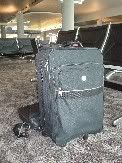Last week I faxed in my application to take the CAE exam. I had been meaning to do that for about 2 weeks, but my travel schedule has been a little crazy and getting to the application has taken a back seat to more essential activities.
As I wrote earlier, getting the 75 hours of continuing education was not a problem. I actually listed 111 hours on my application, and that didn't include every course I had taken over the years. It also didn't include the 18+ hours I'll get from the Center's Fall CAE Immersion Study Course (which the application says I can't list anyway). Furthermore, I was pretty conservative with the hours I listed. I also included authorization to charge $500 to my credit card to cover the application fee.
I phoned ASAE to ensure that it was okay to fax in the application. Mail in DC is still not predictable in the wake of the anthrax scare (at least from my experience), so my preference was to fax it in. I spoke with Greg Melia, the CAE program manager, and he ensured me that fax would be fine. He also noted that some of the folks on ASAE's CAE board have seen this blog.
Last week I also registered as a guest for the Virginia Society of Association Executives monthly lunch meeting where there will be a table for local CAE candidates. The more people with whom to share the preparation, the better.
Finally, I'll be on vacation next week, but I'll not be going anywhere exciting. I'll be reading my books to prepare for the exam. I hope to have finished at least two of the books by September 12th. Blogging between chapters, I hope.
Stand by...
You're about to be redirected to BenMartinCAE.com
August 30, 2004
No turning back now!
Posted by
Ben Martin, CAE
at
5:56 PM
0
comments
![]()
August 23, 2004
Who knew?
I have a newfound respect for bloggers. Jeez, this takes a lot of time!
Having flown to and from Minneapolis, put on five networking events, traveled from Richmond to DC back to Richmond and now to Virginia Beach, and come down with some kind of evil coughing illness -- all in the space of 10 days -- I'm finding myself way behind in my posts. During my flights to and from Minneapolis, I was able to read twelve chapters of Professional Practices in Association Management. The good news is I'm almost half way through with the first book recommended for preparation for the CAE exam. But the bad news is, in the interest of time, my notes may never make it to the pages of this blog. Perhaps I could write some broad synopses, but I don't see anything approaching the detail of my post on governance and structure.
Anyway, greetings from Virginia Beach, where I'm visiting with members this week. Here's a shot of my favorite "pitt" stop when driving to and from Virginia Beach.

Posted by
Ben Martin, CAE
at
9:59 PM
0
comments
![]()
August 19, 2004
Fried Spam
I used to regularly empty my spam folder for my Yahoo! address because it counted against my disk space quota. Once Yahoo!Mail stopped counting spam towards my disk space quota, I began a little experiment to see how many spam messages my filter could pick up in a month's time.

Recently I've seen an uptick in my spam. Usually I hover around 1900, but now I'm above 2000 again. And these are only the messages that the filter picks out. On average I get 1-2 per day that the filter lets through.
From time to time, I'll post my unofficial "Spam Barometer" so you can see where the state of my spam is.
Posted by
Ben Martin, CAE
at
3:59 PM
0
comments
![]()
August 16, 2004
Reflections on ASAE 2004
During the flight home I had an extended opportunity to reflect on ASAE 2004. Here are a few observations. Being brand new to ASAE volunteer leadership, and therefore having an extremely limited sense of the history of ASAE leadership, please take with a grain of salt anything I report to be "new." It's all new to me, really.
First, some members are already sensing a positive change in ASAE culture because of the ASAE-Center merger; many perceive a new spirit of collaboration and opening of doors. For example, ASAE is about to embark on a comprehensive member needs assessment survey. Apparently this will be the first one in many years! (I personally don't recall participating in a membership survey in my five years of membership) That in itself is nothing to get overly excited about, but each section council is being asked for five questions to include in the survey. That was good news to some of the council members, and many said it was an expression of change at ASAE.
In addition to that, the ASAE board has made the decision to include council chairs in strategy development as well as the planning and budgeting process! I applaud the ASAE board for this decision. These steps to include more stakeholders in planning the future of ASAE is fantastic.
However, there seems to be some confusion (and even some fear) about the ASAE-Center merger among the people I spoke with -- even ASAE-Center staff. I suppose these are growing pains, and to be expected. This is a major change, I know.
For example, more than a few of the members I spoke with didn't understand that the Center would be assuming responsibility for all ASAE educational initiatives. I can see how that might be the case if you didn't personally have to vote for GWSAE's dissolution. This revelation was a little troubling for some of my colleagues on the membership section council who thought their input and hands-on development of some programs might be diminished. Some on the council, however, were simply elated to learn that the Center would do more of the leg-work to make programs happen.
Two programs I attended that I feel I should mention. I attended a program on the Association Forum of Chicagoland's member loyalty program. Really cool idea that fits right into the concepts put forward by the authors of one of my favorite blogs. Definitely check out this program on the web at: http://www.associationforum.org/membership/rewards.asp
Also, I attended a roundtable discussion with Jeff DeCagna. Going back to one of my earlier posts on Governance and Structure and the question of to whom does the association belong, Jeff said something during the roundtable that really changed my perspective. He said that "the association is 'owned' by those who contribute to it." One can contribute through dues, or through time, but the point is that staff and members both have 'ownership' of the association. Interesting thought. I'm still processing it.
But the most exciting thing about ASAE 2004 was meeting a few CAE candidates. Already we're talking about study groups and sharing our preparation. And as always, the opportunity to meet new people and reconnect with old friends is well worth the time and money spent to attend these meetings. I'm already planning for ASAE 2005.
Posted by
Ben Martin, CAE
at
10:38 PM
0
comments
![]()
August 14, 2004
A fine day in Minneapolis
Last night the membership section council met for dinner at Zelo and a few of us nocturnal types followed with drinks and the Olympics opening ceremony at the Crowne Plaza.
Before the membership section council meeting I snapped this photo during a walk in Loring Park, a few blocks from the convention center.

I don't have a lot of experience with the council, but today's meeting seemed productive. I volunteered for a subcommittee to look at some of the online resources ASAE offers for the membership section, like the membership section web page, membership section of information central, and the membership section listserve.
After the meeting I took this photo of the skyline near the convention center:

Posted by
Ben Martin, CAE
at
6:43 PM
0
comments
![]()
August 13, 2004
On the ground
I walked what seemed like 3 miles through the Minneapolis airport to find a cab, then sat in traffic for about 20 minutes before arriving at my hotel.
Check out this groovy up-lit sink!

These beds are cool, too.

Posted by
Ben Martin, CAE
at
7:10 PM
0
comments
![]()
I have this nasty habit

I seem to leave my wife and daughter at home by themselves as hurricanes approach. I was traveling when Isabel struck last year, leaving us in the dark for 12 days (I did return in time to share in that suffering). Now I type from Richmond International Airport (courtesy of their free WiFi!) as Charley is bearing down. Fortunately, we appear to be unlikely to get any damaging winds from Charley.
Now boarding all rows. There is much reading for the exam to be done on the plane. Next stop, Minneapolis.
Posted by
Ben Martin, CAE
at
1:52 PM
0
comments
![]()
August 12, 2004
Be nice Bonnie & Charley

Weather permitting, I head out for ASAE 2004 in Minneapolis on Friday night. This will be my first ASAE annual meeting, so I'm obviously looking forward to the experience. Jeff DeCagna, one of my favorite association speakers will be presenting a couple of sessions that I wouldn't think of missing. Connecting and reconnecting with assn managers from around the country is one of the highlights of my professional life, and this will be my second national conference in two months. I'm eager to meet CAEs and to tell them about my blog.
But most of all I'm looking forward with great anticipation to beginning my stint on ASAE's Membership Section Council. Attending my first section council meeting was the real the impetus for going to America's most literate city, Minneapolis. I served for a number of years on GWSAE's ELAC, but it appears ELAC's future is up in the air due to the recent ASAE-Center merger.
I'll post at least once from the Land O' Lakes and Literacy, and upon my return, stay tuned, I'll be filling out my CAE Exam Application.
Posted by
Ben Martin, CAE
at
5:46 PM
1 comments
![]()
Governance & Structure
Chapter 1 of Professional Practices in Association Management. Here we go...
First things first. It's important for your association to be incorporated, and also to have bylaws which typically contain: Membership categories and qualifications; Application and resignation procedures; Membership privileges; Board size: Qualifications of officers; Duties and terms of office; Description of standing committees; Nomination and election procedures; Methods of filling vacancies; Methods for amending bylaws; Indemnification of board and officers; and Procedures for dissolution.
Although 77% of associations give their members direct voting privileges (who are these 23% that don't give their members voting privileges? AAA is one I suppose?) , for efficiency's sake, most associations have a structure of volunteer leaders to run the association. Typical groups in an association are:
Board of directors
This is the main decision-making body for the assn. A three-year tenure is recommended to foster stability from year to year.
Executive committee
A subset of the board, usually its officers, which has the authority to act on behalf of the board of directors.
House (or assembly) of delegates
A delegate representative system of association governance. Basically, a really large board of directors.
Standing committees
Usually they are set up in the bylaws. A board liaison to each committee is recommended.
Special interest groups
a.k.a. SIGs. I always considered SIGs and Membership sections (see below) to be synonymous. Not so, says Wayne Leroy, CAE, the author of this chapter. SIGs are usually "transitional" in nature. They are incubators for an evolving need. However, a SIG may eventually become a Membership section under certain conditions.
Membership sections
Groups of members who organize around a particular issue or geographic area. The terms SIG and section are increasingly being replaced by "community of practice" in much of my reading. I suppose regional chapters would fall into this category as well.
Leroy then turns to strengthening the volunteer relationship. This is one of my core responsibilities currently, so this section was really on-target for me. Leroy encourages assn managers to foster:
Recruitment: Both staff and members should be working to identify future volunteer leaders.
Volunteer Orientation: Volunteer leaders should be familiar with the association's bylaws, policies and procedures, finances, strategic plan, org chart, as well as expectations for them and staff, past activities of their cmte, etc.
Recognition: Recognize members regularly and publicly.
Support: Provide superior staff assistance by arranging meetings, taking and distributing minutes, etc.
Next, Leroy describes the appropriate roles of volunteers and staff. Essentially, volunteers provide the strategy by "establishing direction and policies for programs, products, and services." Staff carries out the strategy by "implementing procedures that deliver the programs, products, and services to the members."
Finally, Leroy stresses that frequent and open communication between staff and the members is extremely important.
This strategy development issue has been on my mind recently. I've been learning a lot about communities of practice recently thanks to Jeff DeCagna and Etienne Wenger. One of the key points they make is that knowledge resides with those who work on the front lines.
We association managers are so far into the nitty-gritty of carrying out the strategies of our respective assns that we often feel we know the strategy best and feel we know what's best for the assn better than our own members. We read the member surveys, we hold ourselves accountable for the assn meeting its goals, we know more members than our members do, in many cases we are more committed to the success of the assn than the members are! This is what we do every single day. So why are the members shaping the strategy, and not the staff?
Despite the above, I firmly believe that associations belong to their members, and rightly so. The ultimate authority for their assn rests with them. But we staff bring a great deal to the table as those who are on the front lines of servicing members. Volunteers and staffs need to realize that they both bring "front lines" experience. Increasingly, I'm learning that the ideal of staff/volunteer partnership needs to be reinforced again and again through the spoken word and in practice. I don't pretend to know how that's best carried out. But for an association to be truly great, it is a belief to which staff and volunteers must both ascribe.
Posted by
Ben Martin, CAE
at
8:57 AM
2
comments
![]()
August 11, 2004
Enough background
Okay, so you've got more than enough background, I'm sure. From here on out, I'll be keeping a diary of sorts on my experiences leading up to the exam, and I'll also be posting notes on my reading. In addition to my notes, I'll provide a related story for each chapter or section of a book, if I can.
Posted by
Ben Martin, CAE
at
9:31 PM
0
comments
![]()
How I'm studying for the CAE exam
As you read in my previous post about how I arrived at my decision to sit for the CAE exam, I'm testing at my first opportunity. I have only five and a half years of association experience (the minimum requirement is five years) mostly at the manager level, so I feel I'm in need of some rigorous preparation for the exam. Here's a quick explanation of how I'll prepare myself for the exam.
ASAE recommends reading three books to get ready for the exam. As you can see in the sidebar of this page, as of this date I'm currently reading Professional Practices in Association Management, edited by John B. Cox, CAE. I plan to read all three recommended works at least once.
I hope to finish my reading by October 13th because I'll begin taking The Center for Association Leadership's Fall CAE Study Course on October 14th. This is a four day immersion cram course for the CAE exam that is in session over the weekend in Washington, DC. I made some calls to graduates of last year's Fall CAE Study Course, and the people I talked to highly recommended it.
However, I wrestled quite a bit with my decision on classroom preparation for the exam. A number of friends and colleagues have gone through the US Chamber of Commerce's Institute for Organization Management. It's a four year program that meets one week per year. Ideally, you go through all four years with the same group of people.
Choosing a classroom CAE prep course was difficult. I was encouraged to attend Institute, but I really wanted to take the CAE exam this year. After talking to people who had gone through the Fall CAE Study Course, I elected to go with it. It was mostly a matter of time for me. Another factor that came into play was that the Study Course provides a practice CAE exam, which as far as I can tell, Institute doesn't offer. But those who have graduated from the Institute and those who are currently in it speak very highly of it. So who knows? Maybe I'll attend Institute after I've earned my CAE.
Once I complete the Fall Study Course, I'll probably cuddle up with the recommended and suggested readings and just try to absorb as much as I can.
Here's where I hope you seasoned CAEs will chime in: leave a comment with your study tips.
Posted by
Ben Martin, CAE
at
6:01 PM
0
comments
![]()
August 10, 2004
Why become a CAE?
Well, simply put, I want to make music my living -- I mean -- I want to make association management my living. I suppose I'm already doing that (most associations are non-profit, but I'm certainly making a profit).
All kidding aside, association work is the field I've chosen to work in for the foreseeable future. It's extremely steady work, it pays pretty well and I find it very fun and fulfilling. So, my decision to take the CAE exam was based on my desire to continue working in associations and to learn about the compartments of associations that I don't work in on a day-to-day basis in order to gain a more balanced view of my role within my company. Plus, it can't hurt my career to add some initials behind my name that are recognizable in the association community. I've had a few co-workers and supervisors tell me that they think I'm CEO material. And while that's very flattering, I'm not so sure I am (honestly). But if, after many years of professional development, I ever decide to go that way, the CAE will help me get there.
In short, becoming a CAE is a wise investment in my professional future. I'm also looking forward to enhancing my knowledge of those areas of associations in which I don't currently operate.
I wrestled for several months with the decision to take the CAE exam early in my career; I'll be taking it at my first opportunity. If I pass this December, I will become a CAE before my 30th birthday. It's certainly possible to pass the exam at an earlier age, but I don't personally know anyone who has (I can think of one person who may have been under 30 when she passed). From talking to the CAEs I know, they all tested in their thirties or forties. Everyone says the exam tests your situational knowledge and that the longer your experience, the better. Obviously, at just five years experience, I don't have a lot of history from which to draw. And I am only an average test-taker. I had average scores on my SATs.
However, I've also never met or talked with anyone who failed the exam (but some people must fail). Close colleagues and complete strangers have encouraged me to test. The preparatory materials are readily available and my employer agreed to cover the cost of a review course (I'll write more about my strategy for preparing in future posts).
Posted by
Ben Martin, CAE
at
8:59 AM
2
comments
![]()
August 06, 2004
What's a CAE?
I'm so glad you asked!
Here's my explanation. CAE stands for "Certified Association Executive." It's a credential for the association management profession that validates (or certifies) an individual's base knowledge of running all aspects of a nonprofit association. Certainly there are specialties within the association profession (lobbying, communications, membership, adult education, etc.), but the CAE designation is generally accepted within the association community as meaning you know enough about associations to run one. In fact, 56% of all CAEs are chief executive officers in their respective associations.
The CAE designation is managed and issued by the American Society of Association Executives (ASAE; the association for people who work for associations). In order to take the CAE exam, one must have requisite levels of experience and education. Upon graduating from college, I had the requisite academic education, but in order to qualify to sit for the exam, I also had to supplement my college education with 75 hours of continuing education in the association management field. Getting 75 hours really wasn't a big deal. It works out to less than three full days of education per year. The hardest part of becoming eligible was getting five years of association management experience under my belt. Having recently passed five years of association work, I decided to go for my CAE (my decision to test will be the subject of my next post).
So, that's my take on what the CAE is. For a more authoritative definition, visit ASAE's CAE page.
Posted by
Ben Martin, CAE
at
2:47 PM
0
comments
![]()
